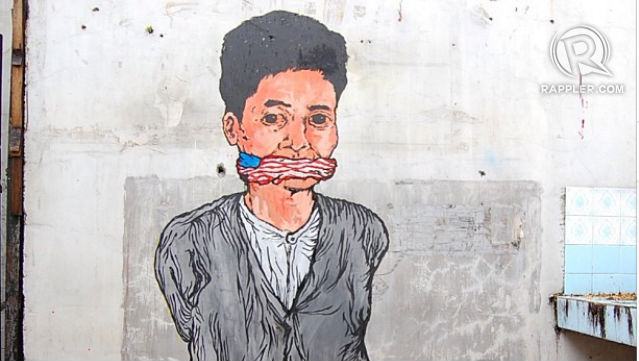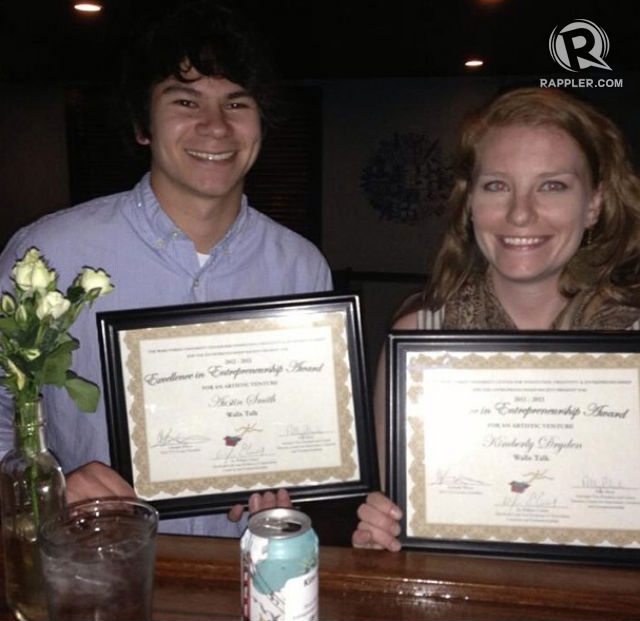SUMMARY
This is AI generated summarization, which may have errors. For context, always refer to the full article.

MANILA, Philippines – Art belongs in frames, behind glass. Art belongs to the walls of galleries and to private collections. Art belongs behind closed doors.
Graffiti artists all over the world have worked to challenge these presumptions. Art, they say, can be brought to the streets.
US-based Austin Smith and Kim Dryden recently started The Filipino Street Art Project to give a bigger voice to these graffiti artists.
They want to amplify these graffiti artists’ challenge.
The transmedia project, which includes the production of a documentary and the cultivation of an active web presence, creates multiple outlets for the growing Filipino street art scene.
READ: Legal graffiti wall transforms city and art
The idea for the documentary was Dryden’s. She knew she wanted to do a piece on the landscape of contemporary art, but needed both an angle and a passionate partner in crime.
Smith, a Filipino-American who grew up in San Francisco, provided both. “When Kim came to me with the idea of creating a transmedia project about contemporary young artists but needed a specific focus, I suggested the Philippine street art scene,” Smith said.
Thus the Filipino Street Art Project, brainchild of a “Filipino-American exploring his roots and a fresh young filmmaker with an obsession for public art,” was born.

“There are few mediums capable of redefining a large swath of urban landscape and influencing daily culture the way street art can. I want to explore how this movement that is, by all evidence, universal across continents and cultures is finding its way in my beloved Philippines,” Smith said.
For Dryden, the intrigue of street and public art is its audience potential. Throughout much of its history, art in the traditional sense was only seen by the very elite, those with the resources to commission portraits.
Even in our modern era, this traditional art remains inaccessible to most, reaching only those with the resources to visit museums or purchase pieces for private collections.
Public art, on the other hand, reaches just that – the public. It is seen by and made for the public.
“What does it mean when a young, educated group of talented artists start addressing bigger issues through a medium that has access to a huge audience?” asked Dryden. “It feels like the perfect storm. At the end of the day, I know street art is big – it’s important in what it can say and how.
“When you throw social media into the mix” – as their project does, expanding the audience of street art even further onto the infinitely large audience of the web – “it keeps me up at night thinking about it.”
Dryden and Smith also explore how to take the Philippines’ street art scene to the next level.
What does street art say about Filipino life and culture? they ask themselves.
As Oscar Wilde’s famous saying goes, “Life imitates art far more than art imitates life.”
Complex look
What, then, does art here on the streets – as close to the breath and grit of mundane life as it can get – have to say about the lives that imitate it?
“As we began to explore [street art] more deeply, we realized that not only is the scene [in the Philippines] booming, it’s coming of age in an incredibly important time in the Philippines’ history,” said Smith.
“The street art sometimes contains really complex, insightful looks at all the changes that are happening. We felt it was the right story, the right place, and the right time.”
While the project is still in its infancy, Dryden and Smith have already been releasing interesting content.
Their blog, filipinostreetart.tumblr.com, features an interview with a local street artist every week. These interviews give us a window into the artistic processes and visions of such artists as Gerilya, Basic Lee, Whoop Wonka, and Eli Killingwithcuteness.
Through these, Smith and Dryden can begin to capture the artistic consciousness of the Philippines’ young but fast-growing street art culture.
Even more exciting things await the pair as they have just been awarded a small grant covering their airfare to the Philippines.
As the two plan their upcoming trip halfway around the globe – for Smith, it will be the first time in years since he has been back to the motherland – we await what this lens into our local urban art and culture will bring to us.

Hopefully, Dryden and Smith will be able to overturn our preconceptions about what exactly makes art.
“Some people think that because street art is on the street, it is inherently less important than art in a gallery or a museum,” lamented Smith.
“But, as we’ve seen around the world, there are so many incredibly talented people who choose to continue working on the street.
“By shedding light on them with this project, we hope in some small way to help show off the street art community, especially in the Philippines, to show general audiences how incredibly moving it can be.”
With the help of Dryden and Smith, maybe we will begin to understand street art for what it really is, and has always been: Art. – Rappler.com
The project, and the pair behind it, can be found on Facebook under Filipino Street Art Project, on their website filipinostreetart.com or by email through filipinostreetart@gmail.com.
Add a comment
How does this make you feel?
There are no comments yet. Add your comment to start the conversation.